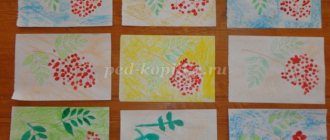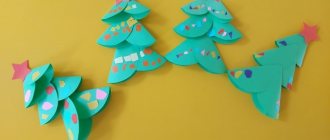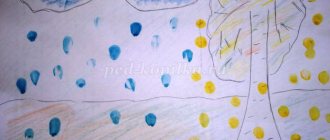Junior group. Early childhood, nursery. Children 1-4 years old
Methodological development for group work with children of early preschool age “Babies and Music” Municipal budgetary preschool educational institution “Krapivinsky kindergarten “Firefly”
Group work program for early musical development “Music and Kids” (1st early age group)
Musical director: Sokolova I.V. Smt. Krapivinsky Explanatory…
Club for an early age group (1.5 years – 3 years) “Our hands are dancing” Explanatory note. In early preschool age, great attention is paid to fine motor skills. circle work plan reflects the content for the development of fine motor skills. Finger games are very emotional and exciting. They contribute to the development of speech, creative activity...
Long-term plan for a club in the junior group; lesson plan (junior group) on the topic
Municipal preschool educational institution
Kindergarten No. 10 “Droplet”
Danilova Nadezhda Nikolaevna
"Colorful fingers"
(Plan of circle work in the junior multi-age group “Kolobok”)
Kozmodemyansk, 2022
Explanatory note. All children love to draw. Having experienced an interest in creativity, they themselves find the necessary ways. But not everyone succeeds in this, especially since many children are just beginning to master artistic activities. Children love to learn new things and study with pleasure. It is by learning, gaining knowledge and skills that a child feels confident. Drawing with unusual materials and original techniques allows children to experience unforgettable positive emotions. Unconventional drawing gives children a lot of positive emotions, reveals new possibilities for using familiar objects as artistic materials, and surprises them with its unpredictability. Original drawing without a brush or pencil relaxes the child, allows him to feel the colors, their character, and mood. Unbeknownst to themselves, children learn to observe, think, and fantasize. The teacher must awaken in every child faith in his creative abilities, individuality, uniqueness, the belief that he came into this world to create goodness and beauty, to bring joy to people. The relevance is that knowledge is not limited to the program. Children get acquainted with a variety of unconventional drawing methods, their features, the variety of materials used in drawing, and learn to create their own drawings based on the knowledge gained. Thus, a creative personality develops, capable of applying their knowledge and skills in various situations. Purpose: The main goal of the classes is to develop children's creative abilities, fantasy, and imagination through non-traditional drawing.
Objectives: 1. Teach children to choose material for non-traditional drawing and skillfully use it. 2. Help children master various technical skills when working with non-traditional techniques. 3. Instill interest in drawing using non-traditional techniques. 4. Develop creativity and imagination. 5. Encourage children to become more active when choosing a topic. 6. Develop a sense of collectivism, camaraderie, and the desire to help each other. 7. Teach to empathize with the mood conveyed in the drawing.
| September | No. | Lesson topic | Technique |
Learn to pick up paint carefully.
Continue introducing color.
Develop aesthetic taste.
- a sheet of white paper;- gray paint in a cup;
-tampon;
-napkins.
2. My favorite rain| Finger painting |
Develop observation, attention, thinking, memory, fine motor skills, speech.
Cultivate an interest in drawing in unconventional ways.
-cloud blanks made in the previous lesson;-blue paint in bowls;
-napkins;
- umbrella for playing.
3. Fly Agaric Finger painting Continue to introduce the non-traditional fine art technique of finger painting. Learn to apply rhythmic dots on the entire surface of the fly agaric cap.Develop a sense of rhythm and composition, fine motor skills, attention, thinking, memory, speech.
Cultivate interest in nature and displaying vivid impressions (ideas) in drawings.
- fly agarics cut out of white paper with a cap painted red;- white gouache;
- cups;
- napkins;
— illustrations of fly agarics.
4. Hedgehog Palm Drawing Give the child the opportunity to experiment with visual aids.Teach your child to imagine and fantasize. Improve hand function, which helps develop eye-hand coordination.
Introduce color. Learn to find similarities between a drawing and an object, and be happy with the result.
- sheets of white paper with the silhouette of a hedgehog;— black gouache in cups;
- napkins.
October 5. Outfits for our dolls Finger painting Teach children to create rhythmic compositions.Develop a sense of rhythm and composition, fine motor skills, attention, thinking, memory, speech.
Make children want to draw beautiful dresses for the dolls living in our group.
— silhouettes of dresses cut out of paper;- dolls;
- multi-colored gouache in cups;
- napkins.
6. Compotes and jam in jars Finger painting Continue to introduce the non-traditional fine art technique of finger painting. Teach children to create rhythmic compositions.Develop a sense of rhythm and composition, fine motor skills, attention, thinking, memory, speech.
Encourage children, using expressive means accessible to every child, to depict fruits and berries that they have identified, tasted and would like to draw
— silhouettes of cans of different sizes cut out of paper;— gouache of red, blue and yellow colors in cups;
- napkins;
- jars of jam;
- teaspoons.
7. Rowan branch Finger painting Continue learning to draw with your finger or a cotton swab. Develop a sense of color and rhythm. To cultivate interest in reflecting impressions and ideas about beautiful pictures (objects) of nature in visual arts. - sheets of white paper with a painted sprig of rowan;- red gouache in cups;
- napkins;
- illustrations of rowan.
8. Fungus Drawing with cereals Introduce the technique of drawing with cereals.Develop children's creativity. Cultivate accuracy and the ability to finish what you start. Development of fine motor skills of the hands.
-sheets of white paper with the silhouette of a mushroom;-brushes;
-PVA glue;
-semolina;
-napkins.
November 9. Affectionate kitten Finger painting Develop fine motor skills, attention, thinking, memory, speech.Cultivate an interest in drawing in unconventional ways. Make children want to help the kitten.
- sheets of paper with a drawn silhouette of a kitten;- toy kitten;
- white, black, orange gouache in cups;
- napkins.
10. Stars in the sky Finger painting Continue teaching children how to create rhythmic compositions.Develop a sense of rhythm and composition, fine motor skills, attention, thinking, memory, speech.
Cultivate interest in nature and displaying vivid ideas in drawings.
- sheets of dark blue paper with applique - roofs of houses;- yellow gouache in cups;
- napkins;
— illustrations with the night starry sky.
11. Sunshine Drawing with cereals Continue to introduce children to the technique of drawing with cereals.Develop children's creativity. Cultivate accuracy and the ability to finish what you start. Development of fine motor skills of the hands.
-white sheets with the silhouette of the sun;-brushes;
-PVA glue;
-semolina;
-napkins.
12. Puppy Drawing using the poking method Learn to draw using the poking method. Strengthen the ability to hold a brush correctly. Strengthen ideas about color. Instill caution when working with paint. Cultivate an interest in drawing. -white sheets with the silhouette of a puppy;-a brush with hard bristles;
- brown paint;
- glasses of water
-napkins.
December 13. Santa Claus Drawing with palms Continue to introduce the technique of printing with palms - learn to draw the beard of Santa Claus.Develop attention, thinking, memory, speech.
Cultivate an interest in drawing in unconventional ways.
- sheets of light blue color;- white gouache in bowls,
- napkins.
14. Santa Claus (continued work) Finger painting Continue teaching children to create rhythmic compositions.Develop a sense of rhythm and composition, fine motor skills, attention, thinking, memory, speech.
Make children want to decorate Santa Claus outfit.
— blanks with Santa Claus’s beard supplemented with appliqué (hat and nose) from the previous lesson. 15. A Christmas tree was born in the forest. Drawing using the poke method Continue teaching children to draw using the poke method. Strengthen the ability to hold a brush correctly. Strengthen ideas about color. Instill caution when working with paint. Cultivate an interest in drawing. -white sheets with a Christmas tree silhouette;-a brush with hard bristles;
- green paint;
- glasses of water
-napkins.
16 Let's decorate the Christmas tree Finger painting Continue teaching children how to create rhythmic compositions.Develop a sense of rhythm and composition, fine motor skills, attention, thinking, memory, speech.
Make children want to decorate the Christmas tree for the New Year.
- Christmas tree blanks made in the previous lesson;-paints of different colors in bowls;
-napkins.
January 17. Beautiful Christmas tree(teamwork)
Palm drawing Continue introducing children to the technique of palm printing.Develop attention, thinking, memory, speech.
Cultivate interest in displaying vivid impressions in drawings; make you want to do collective work, draw everyone together.
- a sheet of Whatman paper;- green gouache in a bowl,
- napkins.
18. Bunny Finger painting Continue to introduce the non-traditional fine art technique of finger painting.Develop a sense of rhythm, fine motor skills, attention, thinking, memory, speech.
Foster interest in drawing in unconventional ways; make children want to help the bunny hide in the winter forest - draw a white fur coat for him
- sheets of blue paper with a drawn silhouette of a bunny;- white gouache;
- cups;
- napkins.
19. Snowman Tamponing Continue to introduce children to a new drawing technique - tamponing.Learn to pick up paint carefully.
Continue introducing color.
Develop aesthetic taste.
- a sheet of blue paper with the silhouette of a snowman;-blue paint in a cup;
-tampon;
-napkins.
20. Who passed here? Finger painting Continue to teach children to create rhythmic compositions, draw with fingers folded in a pinchDevelop a sense of rhythm and composition, fine motor skills, attention, thinking, memory, speech.
- a sheet of white paper;-blue paint in a cup;
-napkins.
February 21. Snowfall outside the window Finger painting- Continue to introduce non-traditional fine art techniques of finger painting. Learn to apply dots rhythmically over the entire surface of the sheet.
- Develop a sense of rhythm and composition, fine motor skills, attention, thinking, memory, speech.
Cultivate interest in nature and displaying vivid impressions in drawings
- sheets of square paper, blue - “windows”;- white gouache;
- cups for paint;
- napkins.
22. Funny octopuses (team work) Palm drawing Continue introducing the technique of palm printing. Strengthen the ability to complement an image with details.Develop color perception, fine motor skills, attention, thinking, memory, speech.
Foster interest in drawing in unconventional ways; make you want to do collective work, draw everyone together.
- a sheet of blue paper - “sea”;- multi-colored gouache in bowls;
- napkins.
23. Snowflake Drawing with cereals Introduce the technique of drawing with cereals. Develop children's creativity. Cultivate accuracy and the ability to finish what you start. Development of fine motor skills of the hands. - a sheet of paper with a drawn snowflake for each child, blue;-PVA glue;
-brushes;
-semolina.
24. Cockerel Palm drawing Continue introducing the technique of palm printing. Strengthen the ability to complement an image with details.Develop color perception, fine motor skills, attention, thinking, memory, speech.
- a white sheet of paper for each child;- bowls with paints of yellow, blue, red, green colors.
March 25. Mimosa sprig Finger painting Practice finger painting techniques, creating an image by using a dot as a means of expression; consolidate knowledge and ideas about color (yellow), shape (round), size (small), quantity (many).Develop a sense of rhythm and composition, fine motor skills, attention, thinking, memory, speech.
Cultivate an interest in drawing in unconventional ways. Make you want to give your mother a beautiful bouquet as a gift.
- sheets of paper with mimosa sprigs;- yellow gouache;
- cups for paint;
- napkins.
26. Beads for Katya doll Finger painting Practice the finger painting technique. Strengthen the ability to apply dots evenly - draw a bead pattern on a thread.Develop fine motor skills, attention, thinking, memory, speech.
Cultivate an interest in drawing in unconventional ways. Make you want to give your doll Katya beautiful multi-colored beads as a gift.
- sheets of paper with a drawn line - thread for beads;- Katya doll;
- multi-colored gouache;
- cups for paint;
- napkins.
27. Chicken Drawing using the poke method Exercise children in drawing using the poke method. Strengthen the ability to hold a brush correctly. Strengthen ideas about color. Instill caution when working with paint. Cultivate an interest in drawing. -a white sheet of paper with a silhouette of a chicken for each child;- yellow helmets
-brushes
28. Small Light Tamponing Continue to introduce children to a new drawing technique - tamponing.Introduce children to the positive and negative properties of fire and the rules of life safety.
Learn to pick up paint carefully.
Continue introducing color.
April 29. Sun (team work) Drawing with palms Continue to introduce the technique of printing with palms. Learning how to quickly apply paint and make prints is like rays of sunshine.Develop color perception, fine motor skills, attention, thinking, memory, speech.
Foster interest in drawing in unconventional ways; make you want to do collective work, draw everyone together.
- a sheet of Whatman paper with a yellow circle drawn in the middle;- yellow gouache in a bowl;
- napkins.
30. Icicles and pieces of ice hung from the roofs Finger painting Practice the finger painting technique. Strengthen the ability to rhythmically apply dots in a certain sequenceDevelop a sense of rhythm and composition, fine motor skills, attention, thinking, memory, speech.
Cultivate interest in nature and displaying vivid impressions in drawings.
- a white sheet of paper with silhouettes of icicles for each child;- bowls with blue paint;
-napkins.
31. Wearing a dandelion yellow sundress Finger painting Practice the finger painting technique. Strengthen the ability to rhythmically apply dots to the entire surface of the sheet.Develop a sense of rhythm and composition, fine motor skills, attention, thinking, memory, speech.
Cultivate interest in nature and displaying vivid impressions in drawings.
- sheets of light green paper;- yellow gouache in cups;
- napkins.
32. Sunny flowers Drawing using the poking method Develop children's ability to draw using the poking method. Strengthen the ability to hold a brush correctly. Strengthen ideas about color. Instill caution when working with paint. Cultivate an interest in drawing. - sheets of light green paper;- gouache of different colors in cups;
- napkins.
May 33. Fireworks Drawing using the poke method Introduce children to the holiday “Victory Day” and an integral part of the celebration - fireworks. Exercise children in drawing using the poking method. Strengthen the ability to rhythmically apply dots to the entire surface of the sheet.Develop a sense of rhythm and composition, fine motor skills, attention, thinking, memory, speech.
-illustrations depicting fireworks;- sheets of blue paper;
- gouache of different colors in cups;
- napkins.
34. Goldfish Finger painting Practice the finger painting technique. Strengthen the ability to apply dots evenly over the entire surface of an object.Develop fine motor skills, attention, thinking, memory, speech.
Cultivate an interest in drawing in unconventional ways. Create a desire to help the mother fish.
- silhouettes of fish cut out of white paper;- mother fish (sample);
- yellow gouache;
- cups for paint;
- napkins.
35. Scarlet Flower Drawing with palms Give the child the opportunity to experiment with visual means. Teach your child to imagine and fantasize. Improve hand function, which helps develop eye-hand coordination. Introduce color. Learn to find similarities between a drawing and an object, and be happy with the result. - sheets of white paper;— gouache of scarlet and green colors in cups;
- napkins.
36. Ladybugs on the lawn. Finger painting Practice finger painting techniques. Strengthen the ability to apply dots evenly over the entire surface of an object.Develop a sense of rhythm and composition, fine motor skills, attention, thinking, memory, speech.
Cultivate interest in nature and displaying vivid impressions in drawings.
- cut out and painted ladybugs without dots on their backs;- black gouache in bowls;
- Whatman paper;
- napkins.
“Colorful fingers” for 2013-2014. report on the performance of the circle.
Since September 2013 In the second junior group there is a “Colorful Fingers” club. The work of the circle is aimed at developing children's creative abilities, imagination, and imagination through unconventional drawing. At the beginning of the year, I developed a long-term work plan, the tasks of which were: 1. Teach children to choose material for non-traditional drawing and skillfully use it. 2. Help children master various technical skills when working with non-traditional techniques. 3. Instill interest in drawing using non-traditional techniques. 4. Develop creativity, imagination, fine motor skills of fingers and hands. 5. Encourage children to become more active when choosing a topic. 6. Develop a sense of collectivism, camaraderie, and the desire to help each other. 7. Teach to empathize with the mood conveyed in the drawing. 8. Consolidate knowledge about shape, color, size. The first lessons of the circle showed that drawing with unusual materials and original techniques allows children to experience unforgettable positive emotions. Unconventional drawing gave children a lot of positive emotions, revealed new possibilities for using well-known objects as artistic materials, and surprised them with their unpredictability. Original drawing without a brush or pencil relaxed the child and allowed him to feel the colors, their character, and mood. The emotional state of the children remained throughout the year; the children were excitedly waiting for the next lesson. Unbeknownst to themselves, children learned to observe, think, and fantasize. Thanks to consistent and systematic work, children at this stage have the knowledge and skills in using such fine art techniques as: - finger painting, - palm painting, - drawing using the poking method, - drawing with grains, - tamponing. Summing up the work of the circle, we can conclude that over the past period the children not only got to know each other, but also learned to master various drawing techniques, compose compositions, and work in a team. Children have developed such mental processes as: attention, thinking, memory, speech, imagination. All members of the circle know the basic colors and their shades, distinguish and name shapes, and differentiate objects (images) by size. The children's interest in the fine arts has noticeably increased; they have become more confident and independent, and more active in educational activities.




